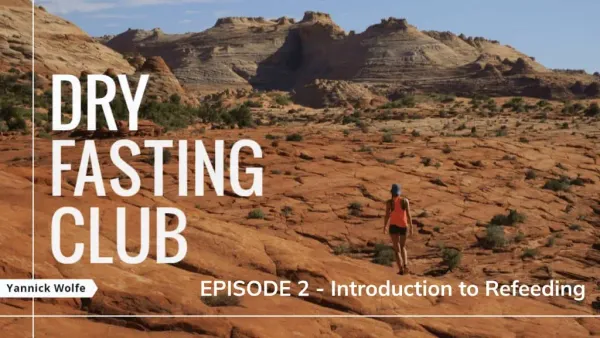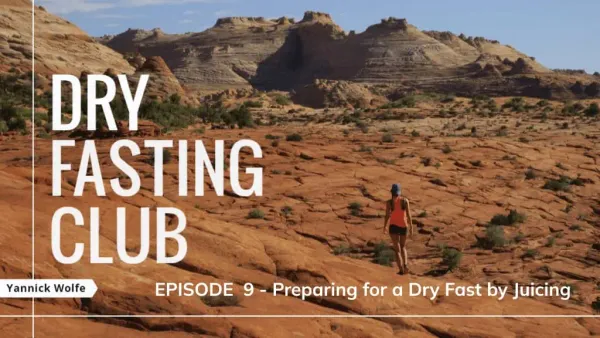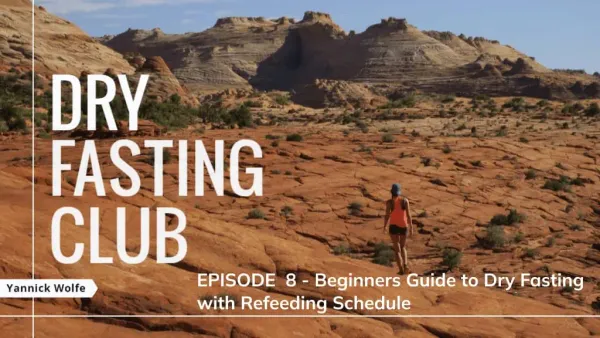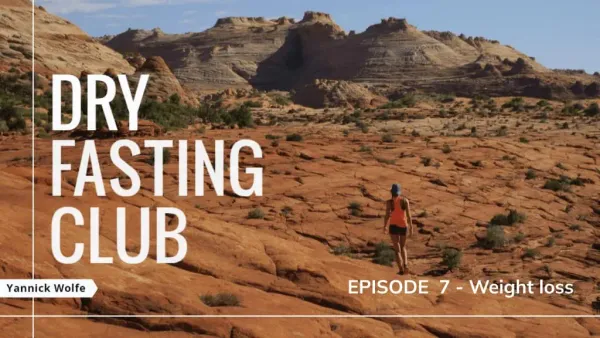Introduction
In the previous episode I mentioned a hypertonic environment in the body and explained it quite poorly. I said that you can imagine it by having more solutes in the blood, when I should have said a higher concentration of solutes to water. Hypertonic basically means there is less water for the same amount of solutes. Think of it as hypertonic – too little water, hypotonic – too much water, and isotonic – just right.
I’d also like to add that, as I’m recording this episode, I am currently on my 2nd day of the 2nd fraction of my fractional dry fast. Fraction-ception.
Fractional dry fasting is a modified method that requires a lot of discipline. I will definitely have a detailed episode all about fractional dry fasting. If I forget, please feel free to remind me in the comments, or send an email to yannick@dryfastingclub.com, i’d love to hear from you. This fractional fasting method takes much longer, but is arguably much safer than a 7 to 11 day dry fast. It reminds me of a blend of rolling fasts with gradual extended fasting.
Why am I currently fasting?
For health. I started dry fasting to get rid of long covid, and with the drastic improvements like nothing I’ve ever tried before (and believe me, I initially tried A Lot of things), I now make sure to maintain and experiment with dry fasting.
If I’m not planning an extended dry fast, I try to maintain a 1 day a week fast. Usually on Thursdays, as they’re my most low stress days and it allows me to enjoy my weekends. I’m looking forward to dedicating an episode to my long covid recovery with dry fasting in the near future.
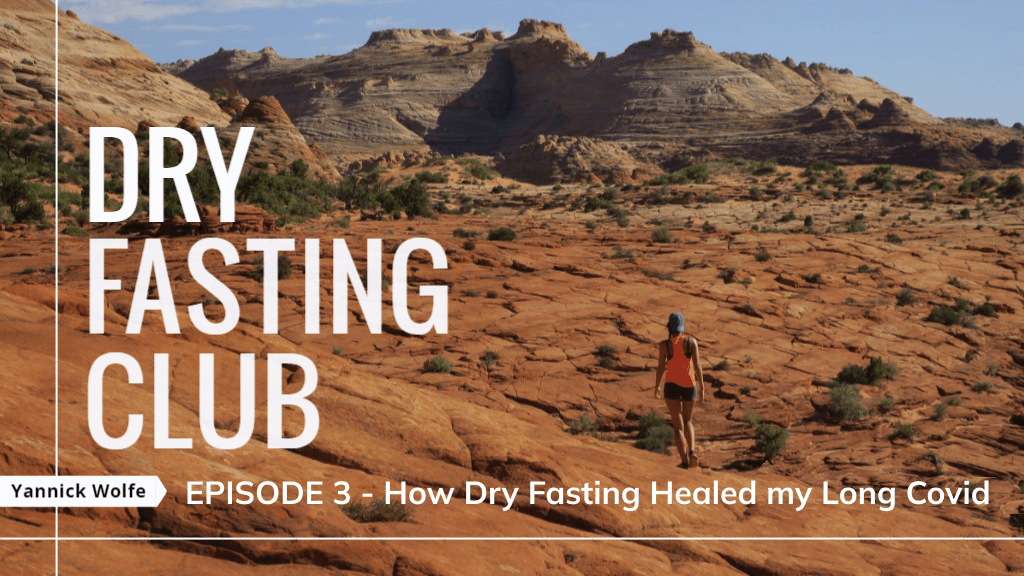
Why even talk about refeeding so early on in the podcast episodes?
I think that a lot of people who come across this podcast will be right in the middle of a dry fast. Whether you’ve extended water fasted or dry fasted, you know that most of your fasting research happens DURING the fast.
I think we’re all aware that as you’re twiddling your thumbs thinking about food, you LOVE to just plop yourself down in front of your phone or computer screen, and start trying to prove to yourself, that this torture you’re going through, is worth it. I mean we’ve all done it! and that, is my reasoning to touch on this topic earlier rather than later.
Refeeding – the most important step after fasting
If you’re fasting and nearing the end, the refeed is your next step. And arguably, its going to be your most important step. Not only is it going to be your next step, it’s going to most likely be cut too short or not done correctly. From people’s experiences, I’m aware that most people don’t view the refeed as being THAT important.
You constantly hear people try to break it gently, but instead of continuing over a few days, they’ll just go straight to meat and eggs. Sometimes still on the first day! Nothing wrong with meat and eggs when it comes to a nutritional stand point, and I know many athletes that have wandered into the world of fasting that love a good steak, but it’s important to remember that meat is very heavy on the digestive system.
What I mean by this is that meat stays in your digestive system longer than most other foods. The protein contained in meat (especially red meat due to fat content) is harder for our body to break down, and this can cause bloating.
What is and what isn’t well digested?
While on the topic of digestion let’s quickly remind ourselves what is and what isn’t well digested.
- Fiber is the indigestible part of plants. The human body and its enzymes actually don’t digest fiber at all. It passes throughout the digestive tract basically untouched. There are benefits to this like fiber making bowel movements easier and the fiber causing a slower absorption of sugar which helps in regulating blood sugar levels.
- Fat is the next hardest nutrient to digest by the human body. Followed by protein, and then finally carbohydrates. Carbs are the simplest nutrient for our bodies to digest. They literally provide energy within minutes after being ingested. The idea of breaking the fast with protein broth, diluted vegetable juices, and porridge starts to make more and more sense. Remind me to dive deeper on this in a future episode.
If anything, remember that chewing your food extremely carefully is the first step in digestion, its called Mechanical Digestion. Then there’s obviously chemical digestion followed by absorption of the nutrients.
What is refeeding?
So I wandered off a little bit, but let’s get back to what is refeeding. The refeed is the final stage of a fast.
It’s the period of time where you gently return to eating full time.
This stage is a crucial part to the dry fast as a whole. If done incorrectly, it can cause a lot of discomfort and potential damage to the body. Worst case scenario, death. But, it’s important to remember that refeeding syndrome is a term thrown around pretty loosely by many fasters and fasting-haters It’s also important to note that most people doing water fasts under 5 days and dry fasts under 3 days have little to worry about. So what is the refeeding syndrome exactly?
Refeeding Syndrome
When people think of the refeeding syndrome they think back to the stories of concentration camp prisoners in world war 2 being liberated by American forces and then given candy bars. These prisoners were starved and most had been living on a slice of bread a day. A lot of these prisoners scarfed down the candy bars and ended up dying shortly afterwards. So the official definition of refeeding syndrome is:
“the potentially fatal shifts in fluids and electrolytes that may occur in malnourished patients receiving artificial refeeding”
People are really scared of the refeeding syndrome. But once again, if you’re doing short fasts, it’s not a big deal at all. Make sure you start the refeed with a little bit of water, and make sure you sip it very slowly. Use this time to feel out your body. Then move on to very watery and easily digestible foods like broth, kefir, and diluted fruit juices.
In fact, your body is so sensitive and fresh after an extended dry fast, that most experts recommend that you do not introduce any pathogenic microflora slash bacteria especially on your first day of refeeding. This means that you’re looking at food like bone broth, vegetable broth, hot porridge, fruit and vegetable compote, and its usually recommended to add lactobacillus and bifidobacterium probiotics with your first water since extended dry fasts kill a lot of your microflora.
A rule of thumb
A rule of thumb used by most dry fasters is that when you withdraw from a fast you need to focus on refeeding gently for about 2x the days that you were fasting. So, a 5-day dry fast should take 10 days of refeeding. For water fasting this is generally on a 1:1 ratio. This shows how much more care needs to be taken withdrawing from a dry fast compared to a water fast. The body goes into that much of a deeper rest.
Why do you need to refeed correctly after fasting?
- To Avoid the refeeding syndrome.
- To maximize healing afterwards. It is said that most healing occurs during the refeed, as this is when the rebuilding occurs. Remember, the fasting portion is the destruction. The refeed is the rebuilding. If you rebuilt badly, think of it like building something with a weak foundation. Like building a new house on a swamp.
- To let your organs and digestive system gradually re-awaken without causing too much of a shock to them. This is why you focus on easily digestible and a gradual uptake of food. This means small meals : small meals are recommended by most experienced fasters. Small meals allow your immune system AND digestive system not to be overloaded. There are claims that many people get sick very often because they eat too much in one sitting. This puts tremendous pressure on your immune system, that could otherwise focus on pathogens trying to gain a foothold in your body.
Why are we focusing on a withdrawal from a 4-5 day dry fast?
So were going to focus on a refeed after a 4-5 day dry fast. Because this is what I consider to be a long fast for 90% of all dry fasters. It is recommended that fasts longer than 5 days should not be done without medical supervision, and although many people still do them themselves, the older and sicker you are, the more dangerous it can be. Refeeding correctly becomes even more important.
What is the most common refeeding strategy after a 4-5 day dry fast?
First off, everyone is different, and its very important to listen to your body. That’s why you need to eat food very slowly and chew very carefully. If you do this, you will give your body time to tell you if you should not be eating what you have prepared.
During the prolonged chewing, sometimes you really don’t like the taste of the food in your mouth OR you simply can’t even taste it. This usually means that your body is not ready to eat this food so early in the re-feed. If this happens, switch to another food, and usually go with something more digestible.
So, bone broth (or fish broth) is widely becoming accepted as the de-facto way to break both extended water fasts and dry fasts. However, with long dry fasts you really want to break it with just clean water, and take slow sips as you bring your body back online. After a few hours you can transition to bone broth. With water fasting, since you’ve already been drinking water and electrolytes this whole time, moving to broth right away is fine. The protein in the broth signals to the body that it’s time to start rebuilding.
Breaking a dry fast
There are 2 major conflicting ideas when it comes to breaking a dry fast:
- One is: No salt and tiny meals starting with things like kefir, compote and broth, this is the refeeding recommended by russian dry fasters.
- The second idea is: Start with electrolytes/snake juice including baking soda, then broth, steamed vegetables, cucumbers, and go from there. This got popularized by Cole Robinson, a very eccentric youtube fasting personality and the inventor of the snake juice.
Which one is correct?
No one knows for certain, but that is why it’s important to cautiously experiment and listen to your body. Dry fasting should never be your first fast. There is a lot you will learn from first trying intermittent fasts, to then trying OMAD (one meal a day), to short and long water fasts, and then finally dry fasting. People call it a fasting muscle and it can only grow with experience.
Which idea do I subscribe to?
I believe that the russian doctors have monitored thousands of dry fasters and their re-feeds. and that there must have been a lot of correlations that indicated that people had a better experience and healing when they did not ingest additional salt for the first few days. There’s some good studies showing an increase in aldosterone during fasting which helps you retain sodium.
Personally, I’ll add potassium to my first meals, since there’s enough research to indicate a bigger need for potassium than sodium after an extended fast. Still, baking soda will alkalize your body, which will bring you out of the ketoacidosis quickly and make you feel better. The question remains: do you want to exit the fast quickly or are you ok with struggling a little more to continue the healing by exiting very gradually.
My personal choices on my most recent dry fast.
My most recent dry fast was 132 hours with an additional 24 hours of water fasting on top of it. I’ve really come to like extending the dry fast autophagy while incorporating rehydration into it. I’m a firm believer that if you want to play it as safe as possible, while also maximizing your benefits of dry fasting, you need to think about extending your fasts with water.
Even though I’m an experimenter and I like to push boundaries, I still have small nagging worries about dry fasting too often and for too long. My solution is to keep dry fasts just under 5 days and add days of water fasting to extend it. That’s why I’m currently experimenting with fractional fasting.
I believe that getting to 3 days of dry fasting is the most crucial step, so that you can achieve that acidotic crisis, and then cruise at this level by water fasting. This gives the option to a lot of novice dry fasters to get to an easily attainable goal, while keeping things relatively safe.
Each fasting experience helps you clean out your body and build a fasting muscle. Normally, most additional fasts will become easier and easier. That’s why a complete beginner to fasting might have terrible symptoms of the fasting flu and be forced to end their fast early.
My way of refeeding
Alright , let’s focus on the details of my 5.5 day dry fast.
- On day one, I drank only mineral water (San Benedetto, which is low in sodium). This means that I had technically transitioned to a water fast and continued a little more healing. I drank as often as I wanted to, trying to sip it slowly.
- On day two I had beef bone broth (sometimes i mix in chicken bone broth). I drank one cup of bone broth every 3 hours. I used to create home made bone broth, but the process was extremely time consuming, so I have switched to organic powdered bone broth. The bone broth was mixed with water at a 1:4 ratio. So in this case, you needed 2 tablespoons of broth powder in 1 cup of water. I did 1 tablespoon in 2 cups of water to reach the 1:4 dilution. I also added small amounts of potassium in the form of nosalt to the broth.
- On day three I had a 1:2 diluted ratio of bone broth, and 1:5 diluted fresh vegetable juice, alternating every 3 hours. near the end of the day I substituted them for 1 cup of milk kefir at 9pm.
- On day four I drank regular concentration bone broth, 1:2 diluted fresh juice, kefir, and I added steamed vegetables and cucumbers. Remember im eating 6 times a day from 9am to 9pm.
From then on, I would slowly add more foods, like cereal porridge (oatmeal that I would blend into a powder), cheese, coconut water, berries and fruits. The key was to make sure that each meal (6 a day) was approximately 1 cup of food.
Conclusion
To summarize everything. Eat 6 small meals a day. No more than one cup of food at each meal. Try to stay away from meat and fatty food for atleast the first 2 days. Avoid salting the food for the first few days, but feel free to add a little potassium and magnesium. Gradually add more varied food, but keep it fresh and healthy.
That’s it for this episode introducing you to refeeding after a dry fast. I hope you enjoyed it. Thanks for listening, if you enjoyed this episode please leave a like and comment if you can, I’d love to see you in the discord as well. Thank you and good luck on your dry fasting journey!
